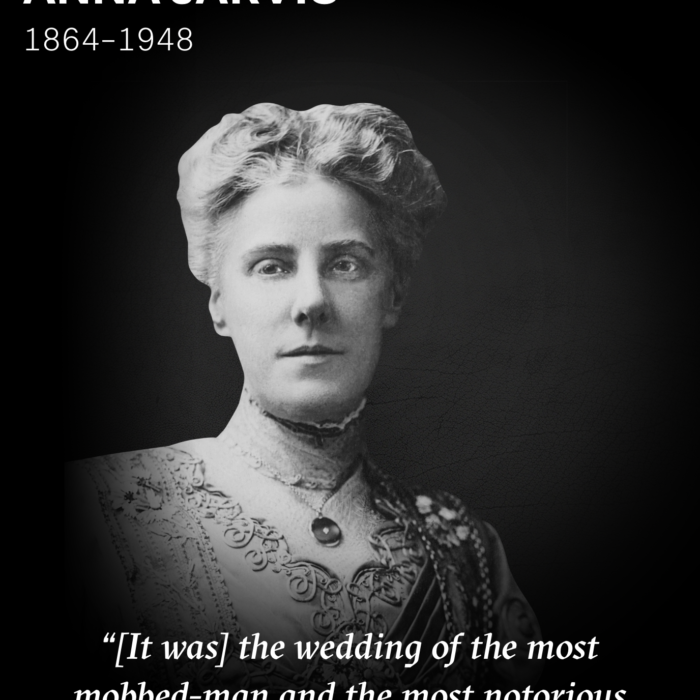
Changemaker name [38]: Anna Jarvis
Dates [15]: 1864–1948
Quote [200]: You are a convincing orator, a brilliant thinker, you will be able to
obtain what you want. Your Mother’s Day idea will honor you through ages to
come.
Quote credit [50]: Russell Conwell to Anna M. Jarvis, May 10, 1908
Image credit [270]: Historical Society of Pennsylvania
Subheader [40]: Inspired by Faith
Synopsis copy [220]: Anna Jarvis, the mother of Mother’s Day, created the
holiday to honor her own mother’s life. A devout Christian, she intended the
day as a simple and spiritual tribute to motherhood.
Image credit [270]: Great Northern Railway via Wikimedia
Subheader [40]: The Story of Mother’s Day
Body copy [220]: Jarvis’s mother, Ann, organized “Mother’s Day Work Clubs”
to care for wounded Northern and Southern Civil War soldiers. She also
worked with families and children struggling with illness caused by poor
sanitation.
Image caption [144]: 1864 Harper’s Magazine illustration honoring the
“heroines” of the Sanitary Commission
Image credit [60]: The Museum of Fine Arts, Houston
Body copy [220]: The holiday may stem from a Sunday school prayer, offered
by her mother when Jarvis was 12, expressing hope “that someone
somewhere” would establish a day commemorating mothers for their service
to humanity.
Image caption [144]: Mother’s Day program featuring a photograph of Ann
Jarvis, the mother who inspired the holiday
Image credit [60]: West Virginia and Regional History Center, West Virginia
University Libraries
Body copy [220]: Two years after her mother’s death, on the second Sunday of
the month, May, 10, 1908, Jarvis organized the first Mother’s Day celebrations
at St. Andrew’s Methodist Church in Grafton, WV, and in Philadelphia, PA.
Image caption [144]: St. Andrew’s Methodist Church in Grafton, West Virginia
Image credit [60]: West Virginia and Regional History Center, West Virginia
University Libraries
Body copy [220]: After Jarvis ordered that 500 white carnations be displayed
on the church altar, the flower became the official symbol of Mother’s Day. It
was chosen because it “symbolizes the purity of a mother’s love.”
Image caption [144]: Mother’s Day seal featuring the white carnation
Image credit [60]: Lancaster Historical Society
Body copy [220]: The popularity of the holiday grew rapidly, garnering much
fanfare and widespread participation. Jarvis was motivated to make the day a
national holiday.
Image caption [144]: 1912 Times Dispatch newspaper coverage of Jarvis’s
campaign to make Mother’s Day a national holiday
Image credit [60]: Chronicling America: Historic American Newspapers,
Library of Congress
Body copy [220]: Encouraged by the popularity of her idea, Jarvis zealously
campaigned to make the day a national holiday. In 1914, President Woodrow
Wilson signed a proclamation designating the second Sunday in May Mother’s
Day.
Image caption [144]: President Wilson’s official proclamation, signed on May
9, 1914, that made Mother’s Day a national holiday
Image credit [60]: National Archives and Records Administration
Body copy [220]: Mother’s Day unified the country during wartime. The day
became a powerful morale booster for World War I and World War II troops.
Image caption [144]: 1942 World War II war bond advertisement encouraging
Americans to purchase war bonds as Mother’s Day gifts
Image credit [60]: National Archives photo no. 179-WP-240
Subheader [40]: Mother’s Day Through the Years
Bubble copy [167]: Jarvis was appalled by and fought against the
commercialization of Mother’s Day. She wished to keep the holiday as a
simple, civic-religious tribute to motherhood.
Date [4]: 1905
Image credit [60]: International Mother’s Day Shrine
Image caption [144]: Program for a Mother’s Day service held soon after Jarvis
created the day
Bubble copy [167]: Early Mother’s Day celebrations were centered around
honoring mothers in church services and encouraging simple acts of
appreciation.
Date [4]: 1920
Image credit [60]: The Hallmark Archives, Hallmark Cards, Inc., Kansas City, MO
Image caption [144]: An early Mother’s Day card designed by Hallmark
Bubble copy [167]: The greeting card company Hallmark began selling
Mother’s Day cards a few years after the day became an official holiday.
Date [4]: 1953
Image credit [60]: Saturday Evening Post / Curtis Licensing
Image caption [144]: Whitman’s Sampler Mother’s Day advertisement
Bubble copy [167]: Within a few decades, elaborate advertising campaigns
were devoted to promoting special products created for Mother’s Day.
Date [4]: 1959
Image credit [60]: The Advertising Archives / Alamy Stock Photo
Image caption [144]: 1959 General Electric Mother’s Day dishwasher
advertisement
Bubble copy [167]: The post-World War II economic boom created a surge in
production and demand of household products. With it, Mother’s Day gifts
moved far beyond a simple white carnation.
Date [4]: 2019
Image credit [60]: Richard Levine / Alamy Stock Photo
Image caption [144]: Mother’s Day reminder in a retail shop window
Bubble copy [167]: By 2019, Mother’s Day had become a 25-billion-dollar
industry. It is the third largest retail holiday in the United States after
Christmas and Thanksgiving.
Subheader [40]: Legacy of Liberty
Question/alignment statement [179]: Do you think that the commercialization
of holidays, however sacred, is inevitable in a society that values economic
liberty?
Image credit [270]: olegdoroshin / 123RF
Scripture [200]: Her children show their appreciation, and her husband
praises her.
Scripture credit [50]: Proverbs 31:28
Image credit [270]: Historical Society of Pennsylvania
Related changemakers: Rebecca Gratz, Dorothy Day, Jane Addams